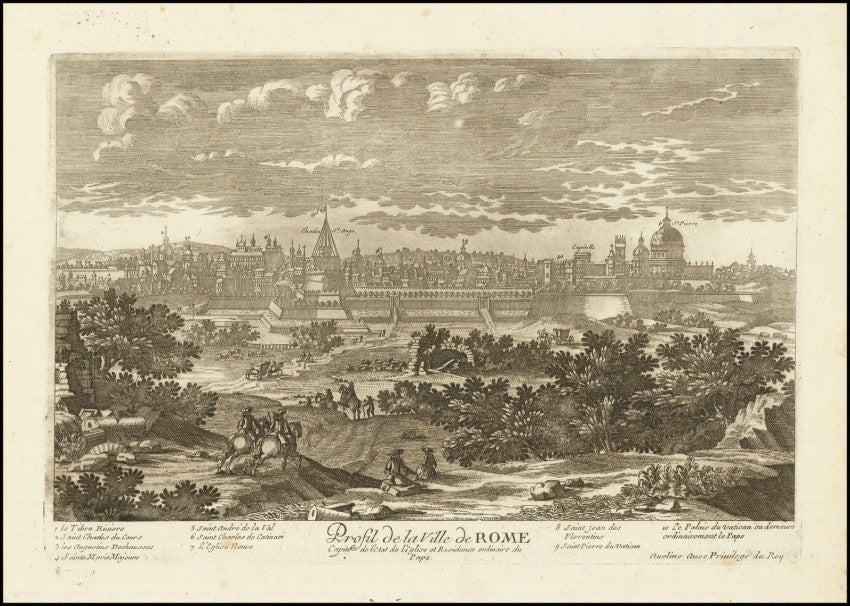
The city of Rome in 1700
Alice PettirossoShare
Rome 1703: between seismic tremors and baroque splendor, the Eternal City rediscovers itself
In 1703 , the city of Rome was shaken not only by the power of seismic waves, but also by the fears and emotions of its inhabitants. On January 14 of that year, a strong earthquake struck the city and the surrounding regions, leaving its mark not only on its walls, but also in the hearts of the population. The event, known as the Rome earthquake of 1703 , had effects far beyond the material damage, undermining the safety of a Rome that was living in the full splendor of its baroque.
Rome between earthquakes and baroque: the challenge of a Pope and a city
In a vibrant and luminous 18th-century Rome , where the Baroque shaped the squares and palaces, the earthquake appeared as an ominous signal. Pope Clement XI, who ascended to the papal throne in 1700 , found himself facing a crisis that put to the test not only the stability of the architectural structures but also the faith of his citizens. In Rome the damage was less serious than the devastation that struck L'Aquila and the valleys of Umbria, but terror spread rapidly. Many interpreted the tremors as a divine warning, a call to a more intense devotion.
Clement XI's reaction was decisive and compassionate: he opened the doors of churches to the homeless, distributed food to the neediest, and organized intercession masses and processions to invoke divine protection. One of these, particularly charged with symbolism, passed in front of the Pantheon, where a sudden clap of thunder echoed, reawakening the fear of the still shaken faithful. The pope promptly managed to calm the crowd, interpreting the sound as a sign of divine power watching over Rome . A gesture that restored hope, strengthening the perception of the Church as a spiritual beacon in a time of great uncertainty .
Roman Baroque and the Fragility of the Eternal City
Rome , at the height of its Baroque era, was a stage on which the Church played the leading role, with the Pope as director and architects as skilled set designers. The city shone with grand projects, such as the expansion of the Basilica of St. John Lateran, and the opulence of the decorations in its churches and palaces. But the earthquake of 1703 also revealed the fragility of such grandeur: some ancient structures and new buildings collapsed, demonstrating the need for care and restoration. The seismic event stimulated a new awareness of heritage conservation, paving the way for a growing interest in archaeology and anticipating the future explosion of Neoclassicism.
A city between the sacred and the profane, between faith and tourism
Despite the fear that crept through the alleys of a city of about 140,000 inhabitants, Rome continued to be a magnet for European pilgrims and intellectuals. The Baroque, with its sinuous curves and spectacular facades, was intertwined with a renewed interest in the vestiges of antiquity. Processions and religious celebrations, such as those following the earthquake, punctuated daily life, strengthening the bond between the population and the Church. At the same time, the first signs of a passion for the ancient heralded an era of excavations and restorations that would bring back to light forgotten treasures, from the area of the Imperial Forums to classical statues.
Rome was also a crossroads of knowledge, with the Vatican Library and academies attracting scholars from across the continent. The Grand Tour, an essential experience for young European aristocrats, brought to the city figures such as Johann Joachim Winckelmann, who developed a new aesthetic in Rome linked to ancient art. Thus, 18th-century Rome served as a bridge between Baroque grandeur and a rediscovery of classicism.
Rome on the move: crisis and rebirth between squares and construction sites
Despite the earthquake, Rome 's vitality did not stop. The city continued to expand and transform, led by Clement XI and his successors, who invested in major works such as the construction of the Trevi Fountain, begun in 1732. Rome was a mosaic of contrasts: the splendor of the noble palaces alternated with the poverty of the alleys, the baroque squares came alive with markets and fairs, such as that of San Giovanni, where merchants and artisans met in a lively exchange.
But the transformations were not only aesthetic. The earthquake of 1703 had taught the Romans to see the city with new eyes, to consider beauty as something fragile, to be protected and cherished. And so, between the sacred and the profane, between the tremors of the earth and the flashes of art, Rome faced the new century, suspended between the desire for renewal and respect for its glorious heritage.
A century of changes
The earthquake of 1703 was just one episode in the long journey of transformation that Rome went through in the eighteenth century. Between the echoes of the tremors and the fervor of the construction sites, the city was preparing to enter the Modern Era, preserving its baroque soul but also opening itself to the rediscovery of the ancient and the first intuitions of the Enlightenment. Rome remained a symbol, a center of spirituality and culture, where every corner told a story and every stone reminded us that, like the Pantheon after the thunder, the eternal city always knew how to rise again.

